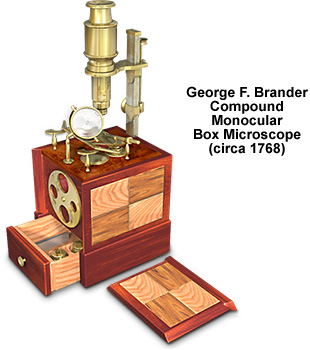George Brander Compound Box Microscope
Utilizing a finely crafted wooden box as a stand and foundation, this beautiful German microscope was fashioned by George F. Brander sometime around 1768 in Augsburg. The model featured below was redrawn from photographs of the original microscope, which is part of the Billings microscope collection at Walter Reed Army Hospital in Washington DC.

The ornamental inlaid wooden box serves a dual role as the base for the microscope and also houses a rectangular mirror, which spans from one side of the box to the other and is adjustable along a horizontal axis. A removable panel slides over the upper front portion of the box to protect a revolving disc of diaphragms. The sliding panel must first be removed in order to permit light to enter into the box and reflect from the mirror surface. This light is then directed upwards through an aperture that perforates the center of the top of the box.
The body tube is centered over the opening and is secured to a rectangular pillar by a fixed arm. Positioned between the aperture and the body tube is the stage frame that balances on finely turned pegs. Optical fittings in the body tube include a single eye lens and a field lens. Fine adjustment is achieved by manipulating a Cuff-type screw to lower or raise the body tube. The lower portion of the box features a pullout drawer and is designed to contain auxiliary objectives, forceps, and a fishplate. Similar instruments were crafted in Italy and France between 1750 and 1780.
BACK TO EIGHTEENTH CENTURY MICROSCOPES
